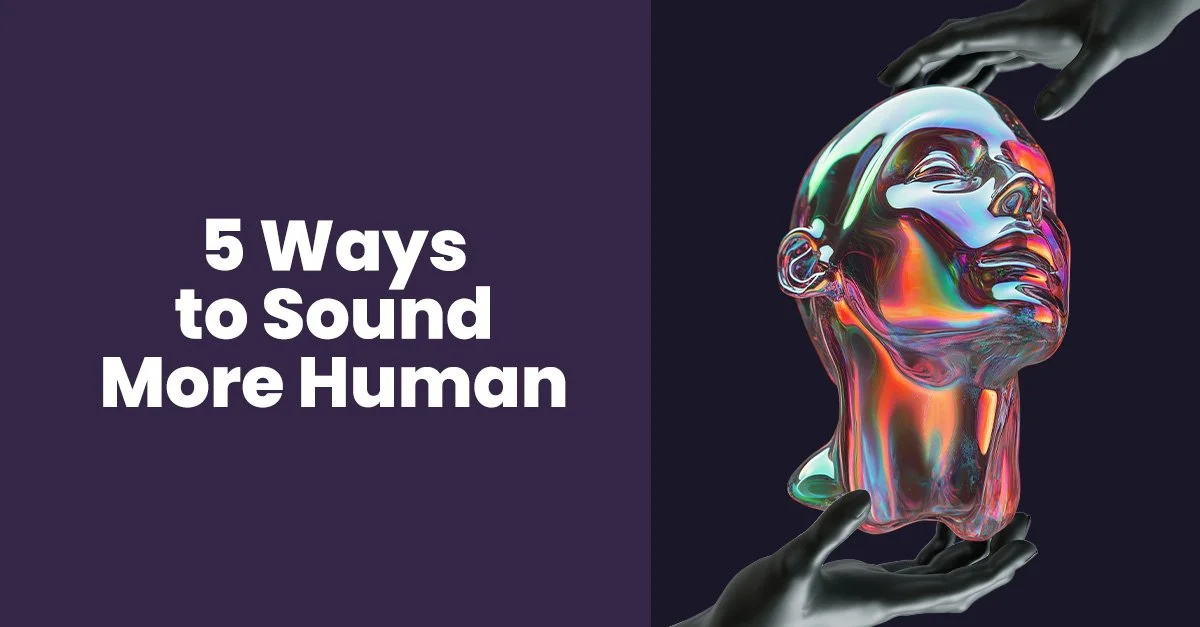5 Ways to Sound More Human
A Short Guide For Humans, Written By Humans
Hi. If you’re reading this, chances are you’re a human. Which is perfect because this was written just for you. Otherwise, you’re probably an advanced AI bot that’s scouring the web looking for content like this to help you better disguise yourself so you can take over the human race. (We’re kidding…kind of.)
Even though we don’t literally think AI is here to “take over,” it's definitely changing things about our daily lives in ways we never expected. According to several researchers and studies from institutions like Max Planck Institute for Human Development, UC Berkeley Tech, and Cornell…our everyday speech patterns are starting to mimic AI language models like ChatGPT.
In other words: We’re all starting to sound like a bunch of robots in a giant echo chamber.
And the way we see it through a marketing agency lens, this has the potential to be bad for business. Because the key to a brand’s growth lies in being able to effectively communicate on a human level.
Everything from client presentations to internal comms (Slack, Outlook, Teams, etc.) to consumer-facing messaging all the way to your customer service reps –– this “bot-speak” is taking over.
But luckily for you, this short guide is here to help your brand connect with people –– whether in the boardroom or through a paid social ad –– in the most authentic ways possible.
1. Write how you speak. Speak how you speak.
You know how when one of your friends asks you about a new Netflix series and you respond by saying, “the efficacy of the plot twist left quite the smile on my face”?
No? Well, that’s because you more than likely said something like, “dude…that show was crazy!” Because if you did talk like the example above, you’d sound a little too try-hard or unnatural, which is the quickest way to lose your audience’s attention span.
To keep your audience’s attention, it’s simple: Be honest. Be authentic. Be you. The little quirks that go against “best practices” are what makes you (or your brand) unique. And in a virtual world where everyone is beginning to sound the same –– individuality is your hottest commodity.
2. Are you really gonna’ use that word?
Some words just reek of AI. According to researchers at the Max Planck Institute for Human Development, words like “delve,” “meticulous,” and “realm” are used up to 51% more frequently than in the three years prior to the introduction of ChatGPT.
Now, we’re not saying that having an extensive vocabulary is bad. But this information begs the questions: Are we training AI? Or is AI training us?
Several studies have shown that using short, simple-to-understand words lead to a phenomenon called “processing fluency.” Since we humans rely on our feelings to process information…when it’s easy to process, it just “feels better.” And these kinds of positive associations are some of the most powerful and underrated tools that help brands build trust.
3. Use phrases and idioms from your neck of the woods.
Communication –– whether written or spoken –– is how culture is shared. And sharing culture is the key to connection. As we slowly drift deeper and deeper into this echo chamber, we’re at risk of becoming one big blob of uniformity that sounds like a bunch of meme-speak bots.
As a marketing agency who specializes in multicultural communication, this is sad to see. Because the beauty of sharing culture and using it as a means of bringing people together is a powerful weapon for a brand’s marketing arsenal.
No matter what corner of the world you come from, there are nuances and quirks that other people have yet to see or hear. Even if they seem commonplace or ordinary to you. Whether it’s a saying, a joke, or even a simple gesture –– sharing these are a surefire way to stand out and connect.
4. Ditch the script.
How many times have you heard a customer service rep say, “I understand your frustration. Please bear with me as I review your account”?
Half the time, we’re not even sure we’re talking to an actual human. We understand the need for a script as an outline, but not at the cost of sounding void of all human emotion.
Doesn’t “Oh my gosh, I’m so sorry that happened. Let’s see what we can do” sound so much better?
The lesson here is to lead with empathy. Whether you’re the CEO of a brand, the creative director of their marketing account, or the customer service rep –– you have to listen. Listening to your audience’s problems is the only way to truly solve them. And solving your audience’s problems…well…that’s the only way to grow.
5. Remember…we’re all human.
Your CEO is just a person, not a God. Your employees are people, not machines. And your customers are real people with real problems, not data points on a screen.
The key to genuine connection in business and in life is great communication. And the key to great communication has always been –– and will always be — humanity.
Check out how we tap into deep cultural insights to connect brands with new audiences here.

